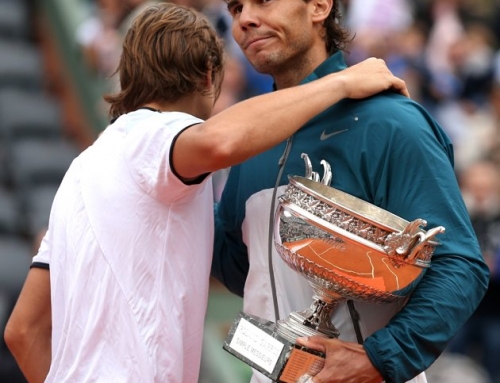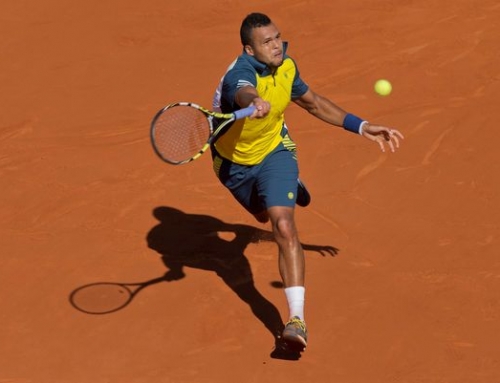 As the hour headed to about 7 PM, there was a battle brewing on Court Philippe Chatrier. The ESPN announcers astutely observed that if Tsonga didn’t win the match in straight sets, he would lose in 5 sets. The reason? Stamina.
As the hour headed to about 7 PM, there was a battle brewing on Court Philippe Chatrier. The ESPN announcers astutely observed that if Tsonga didn’t win the match in straight sets, he would lose in 5 sets. The reason? Stamina.
Tsonga, like his countryman Monfils, is susceptible to injury. When you’re injured, it can be challenging to work on your fitness. You can strike the ball well, but can you get to the ball quick enough. Observers noted that Federer would shank and wonder what was wrong with his game. It may simply be that Federer was a hair slow, and his precision game requires very good footwork speed.
Up until the third set, Tsonga had been using his power to get the edge over the Swiss. He took the first set, but fell a break behind in the second. Tsonga was not only able to even up the second set, but take the second set in a tiebreak. When Wawrinka was able to seize the third set in a tiebreak, he knew his superior fitness would win the match. From then on, it was 6-2, 6-3 to Wawrinka.
However, there was a problem. By the fourth set, the match was rolling to about 7 PM Paris time. Paris has late sunsets that don’t happen until about 9:30 PM. This allows matches to be played in daylight until quite late without lights. In the last two years, the setting sun created controversy, both with Gael Monfils. Two years ago, Monfils was scheduled to play Roddick (who skipped this year’s French due to injury). As the sun began to set, Monfils insisted there was enough light to play. Roddick desperately wanted the match to go another day. Whether the daylight would have helped, well, Roddick was likely to lose to the speedy Frenchman.
The following year, Monfils again insisted in the waning daylight, that there was enough light to play while Fabio Fognini, supposedly a friend of Monfils, complained the officials should call the match. The match was heading into 10 PM and both players were literally moonballing into the middle of the court, because they couldn’t see the lines. The match was finally called due to darkness, and Fognini won it the following day as if to spite the tall Monfils for his gamesmanship.
Even if Djokovic and del Potro would get onto Court Philippe Chatrier, the center court at Roland Garros, it would be past 7 PM, perhaps close to 8 PM and mean 2 sets of play max. This was not only the product of the Wawrinka-Tsonga match going 5 sets, but also the two previous women’s matches going the full 3 sets too.
It was agreed to start the match on Court Suzanne Lenglen to try to get some of the match started. There was a strong chance the match wouldn’t be finished.
In the first set, del Potro went with his straight forward power. Djokovic seemed to be able to handle this power and took the first set 6-3. Early in the second set, Djokovic’s accuracy seemed a hair off. Shots that he had been making during his streak were suddenly falling wide. That and del Potro’s formidable power were shots he hadn’t faced in some time. Nadal doesn’t hit this hard. Federer doesn’t hit this hard. The clay allows del Potro just enough time to get to balls and then occasionally tee up for a huge forehand.
Djokovic coughed up a few errors and gave del Potro a break. Djokovic would get a chance to break late in the second set when he got to 15-40. Two big serves later and del Potro reached deuce. Indeed, one advantage del Potro has that other rivals don’t is his pure MPH on the serve. He has, speed-wise, maybe the third fastest serve in the game behind Karlovic and Isner. And he’s able to dial it up when it mattered. Once del Potro escaped that game, the set was over.
Although they could have played maybe another 20 minutes, darkness would have been called in the middle of a set. Both players agreed to halt play at a set a piece.
So what to conclude from the match. First, del Potro is moving well enough to retrieve Djokovic’s shots. He’s doing this by standing way, way back. Second, del Potro’s power is giving Djokovic some trouble. One huge advantage del Potro has over his rivals is that power. The big forehand is not something he pulls out just against certain opponents. He has it ready for every opponent. So he doesn’t feel stress trying to hit a shot bigger than he is comfortable. This is the pace he prefers.
Third, Djokovic’s game is a hair off. Djokovic has to hope that the lack of light is causing him to miss shots. If that’s the case, the continuation of the match, which is after noon should be in plenty of light for him to regain the accuracy he needs to play his game.
Finally, there is the issue of fitness. In the past, Djokovic’s fitness was called into question, but he seems to resolved these issues. On the other hand, del Potro’s fitness issues are a question. He also had issues with the heat back when he was in his prime, though he seemed to fight his way through it (especially against Roddick). But with two sets played, the rest of the match becomes a best of 3 set match. That still means a little recovery time needed by both players, but Djokovic is used to playing back to back days in Masters events. del Potro hasn’t had to do much of that yet.
My feeling is that Djokovic manages to get his game back, and while it is tight, those close shots start to fall in, and del Potro goes on the losing end of those rallies. But del Potro is playing remarkably well to stay more than even in those rallies, so I’m impressed. I felt, for sure, that Djokovic would move the ball around and del Potro would be unable to handle it. Yet, Djokovic tossed in drop shots and del Potro seemed more than up to the task of getting to the shots.
This match will be conclude after the Murray-Berrer match. Murray has been struggling through an easy draw. He has played low ranked players that have nonetheless pushed him. He’s yet to drop a set, but he would like a clean match where he dominates an opponent. I’m not sure that it will happen with Berrer, but Murray does usually have a match or so where he does play really well, so that’s yet to come. Berrer is a tall guy just a shade taller than Murray, but he’s a lefty and he’s 30. Presumably, Murray will want to test his movement and fitness. The two have never played each other.
Rafael Nadal is also looking for a clean match. It was somewhat understandable that a good John Isner would be able to play hot against Nadal. But then he struggled through a straight set match against Pablo Andujar. Despite both being Spaniards, Nadal had never played Andujar in an official ATP match. Andujar was serving for the third set, up 40-15, and somehow lost the set with nerves and Nadal’s play coming into play.
Right now, I’m not too concerned with Nadal’s play. It’s true he often regresses to defensive pushing when he gets nervous. This means hitting short shots and not going for the lines. Nadal has this dual personality. When he feels he’s losing, he often goes for his shots. But up until then, he’ll play nervously, but safely, with shots played up the center and having no particular oomph or direction. He’ll hope his opponent attacks and forces Nadal to have to hit big shots (or they miss as they try to end the point).
But, this has happened before. Last year, at Wimbledon, Rafa played two back-to-back 5 setters. But he settled his game down with a thumping of Soderling and then more or less thumped Murray. He was sharp again for the final. Nadal has an incredible ability to recover.
Now, if he struggles against Veic, who is a qualifier, then I’m prepared to believe that Nadal is off his game for some reason. Veic beat Davydenko in five sets, but this Davydenko appears to be a shadow of his previous self. He can no longer get the nice angles that put him in the top ten and had him hoisting a trophy at the year end event in 2009. He is making too many errors and his opponents are able to dictate play. Davydenko’s brother and coach observed that Nikolay is not running as well as he should be and this is likely the root of his problems.
Mardy Fish plays Gilles Simon in a third round match. Fish has never been past the third round at the French, but he has higher expectations of himself. He’s had a pretty cushy draw so far. Simon is likely to pose more of a challenge, but Fish might be able to take him on. Both are fit players. Simon relies on speed, fitness, and his ability to chase down balls to win. He’s David Ferrer-lite, without Ferrer’s ability to push his opponent on the defense. Fish has a huge serve. He mainly has to worry about how steady he can play. I think it’s winnable for Fish, but it will be tough.
Another interesting match is Alexandr Dolgopolov and Viktor Troicki. The winner of this match will play the winner of Murray-Berrer.
Soderling is also completely under the radar. He has a pretty good chance to reach Nadal in the quarterfinals. He would have to get past Leonardo Mayer and the winner of Fish-Simon. This could become interesting in week 2 of the French Open.




![[French Open] The tactics of the Djokovic-Nadal semifinals](https://www.essentialtennis.com/wp-content/uploads/2013/06/20130607nole-500x383.jpg)
![[French Open, SF] David Ferrer defeats Tsonga in straight sets to reach first Slam final](https://www.essentialtennis.com/wp-content/uploads/2013/06/20130607ferrer-500x383.jpg)
![[French Open, SF] Nadal escapes epic 5-setter with win over Djokovic, to compete for 8th title](https://www.essentialtennis.com/wp-content/uploads/2013/06/20130607rafa-500x383.jpg)
